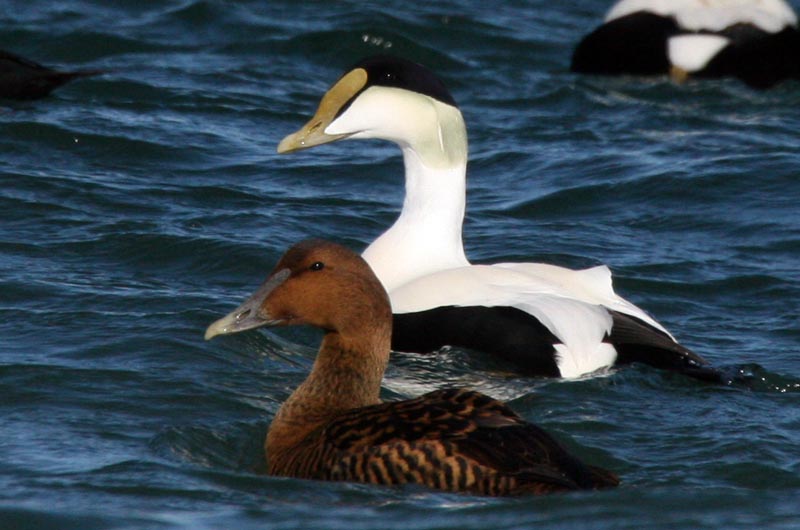The Christmas Bird Count was on Jan. 3; we are now in the process of finalizing the results, which will be published in the Gazette soon. There have been a lot of birds sighted this week, so here goes.
Probably the best bird of the week is Dick Jennings’s observation of a common yellowthroat at his Tisbury feeder on Jan. 6; it was hunkered down along a border of liriope that surrounds the bird feeders. This is a good sighting because it is uncommon at this time of year, although it is common in the breeding season.
Anything that has bright orange feathers is also a welcome sight at this time of the year. Thus, it is good to hear that the West Tisbury Baltimore oriole has survived more cold weather. This time the bird was observed at Heidi and Ronnee Shultz’s feeder on Jan. 12. Nancy Dole observed the oriole perched in a pine tree in her yard on Jan. 11. And Ronnee Schultz reported the oriole amidst snowflakes near the Agricultural Hall in West Tisbury on Jan. 6, so this bird has recently headed a little bit northward to the State Road area. Please keep reports of this bird coming so we can track its movements, hopefully through the winter.
Joan Malkin is thrilled to have a new neighbor, as she discovered a screech owl is living in the nesting box that she got from the Nature Conservancy a few years ago. Since society rapidly cuts down dead trees, appropriate nesting cavities can be in short supply, which is why bird houses can be so important.
Liz Goud reports that there is a great blue heron hanging around her home, regularly perching in a tree or near the driveway.
Speaking of yards, Jacqueline Beauvais Cromwell just got a new field guide and immediately put it to work and identified northern flicker, red-bellied woodpecker and cedar waxwing on Jan. 12.
Soo Whiting and Flip Harrington observed a snow goose in Whiting’s Field next to the West Tisbury cemetery on the afternoon of Jan. 13. This is probably the same lone snow goose that was observed on the nearby Mill Pond on the Christmas Bird Count. The same day, Tim Johnson observed the flock of snow geese that has been present at the Keith’s farm on Middle Road in Chilmark. Roger Cook observed four there on Jan. 7.
Stan and Marie Mercer called to report four eastern bluebirds in their Menemsha Crossroads yard on Jan. 12. They were excited since these were the first bluebirds they had in their yard in several years.
Samantha Chaves used her telephone to take a picture through her binoculars of a snowy owl at the Katama air park on Jan. 11. Such photography takes practice to get a good image, but is a useful technique for confirming a bird sighting. Believe it or not, there are binoculars that have built in cameras! I may need one since other authors of this column occasionally comment that I should carry a camera with me.
Providing shallow, ice-free water will attract more birds to everyone’s yard. Charlie Kernick had a flock of robins and white-throated sparrows coming to his heated bird bath on Jan. 11. William Waterway has observed robins and cedar waxwings at his heated bird baths, while Gretchen Eliot Regan had some eastern bluebirds and house finches visiting hers. Providing heated water means you do not need to remove the ice every day, or sometimes multiple times in a day, to attract and enjoy the birds.
Flip Harrington and Soo Whiting had two female eastern towhees at their Quenames feeder on Jan. 10.
A covey of about 12 northern bobwhites were attracted to Judy Bryant’s West Tisbury feeders on Jan. 10. This is a species that is really rare now, and is especially hard to find during the winter when they are not calling, so many are envious of her covey.
Still hanging in there at the Oak Bluffs pumping station are the common moorhen, American coot and ring-necked duck. I found them there on Jan. 10; they were hard to see as they were all tucked under the shrubbery in the open water near the pipe from the pumping station building. I also observed three purple sandpipers foraging on the old decrepit jetties near the end of the seawall across from Farm Pond.
On the raptor front, both Annie Carmichael-Lemenger and Dan Whiting spotted a peregrine falcon at Tashmoo on Friday, Jan. 9. And Tim Leland called to report a Cooper’s hawk at Wasque the same day.
It is always fun to talk about a new species for the Vineyard. Multiple observers have seen the spotted towhee since it was found on the Jan. 3 Christmas Bird Count. Most recently, Ken Magnuson found it on Jan. 8, and Allan Keith, Lanny McDowell and Soo Whiting have all found it. While it remains in the same locale near Squibnocket, it also stays deep in the shrubbery and rarely provides anyone with a clear, unobstructed view.
Last but certainly not least, Soo Whiting received a garbled message about a rusty blackbird sighting at a feeder in Edgartown. This would be a remarkable sighting if it can be confirmed, as this species is now quite rare. Unfortunately, we could not understand your name or your phone number, so please email or call the Gazette so we can get the details of your sighting.
There are lots of birds around, so please get out looking for them, and be sure to report your bird sightings to birds@mvgazette.com.
Robert Culbert leads guided birding tours and is an ecological consultant living in Vineyard Haven.





Comments
Comment policy »